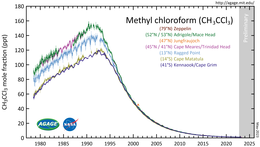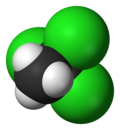| |||
| |||
| Names | |||
|---|---|---|---|
| Preferred IUPAC name 1,1,1-Trichloroethane | |||
| Other names 1,1,1-TCA, Methyl chloroform, Chlorothene, Solvent 111, R-140a, Genklene, monochlorethylidene chloride (archaic) | |||
| Identifiers | |||
| CAS Number | |||
| 3D model (JSmol) | |||
| ChEBI | |||
| ChEMBL | |||
| ChemSpider | |||
| ECHA InfoCard | 100.000.688 | ||
| EC Number |
| ||
| Gmelin Reference | 82076 | ||
| IUPHAR/BPS | |||
| KEGG | |||
| PubChem CID | |||
| RTECS number |
| ||
| UNII | |||
| UN number | 2831 | ||
| CompTox Dashboard (EPA) | |||
InChI
| |||
SMILES
| |||
| Properties | |||
| Chemical formula | C2H3Cl3 or CH3CCl3 | ||
| Molar mass | 133.40 g/mol | ||
| Appearance | Colourless liquid | ||
| Odor | mild, chloroform-like | ||
| Density | 1.32 g/cm | ||
| Melting point | −33 °C (−27 °F; 240 K) | ||
| Boiling point | 74 °C (165 °F; 347 K) | ||
| Solubility in water | 0.4% (20°C) 0.480 g/litre at 20 °C | ||
| Vapor pressure | 100 mmHg (20°C) | ||
| Refractive index (nD) | 1.437 | ||
| Hazards | |||
| Occupational safety and health (OHS/OSH): | |||
| Main hazards | Ozone layer impact. Irritant to the upper respiratory tract. Causes severe irritation and swelling to eyes. | ||
| GHS labelling: | |||
| Pictograms | 
| ||
| Signal word | Warning | ||
| Hazard statements | H332, H420 | ||
| Precautionary statements | P261, P271, P304+P312, P304+P340, P312, P502 | ||
| NFPA 704 (fire diamond) |
 | ||
| Explosive limits | 7.5%-12.5% | ||
| Lethal dose or concentration (LD, LC): | |||
| LD50 (median dose) | 9600 mg/kg (oral, rat) 6000 mg/kg (oral, mouse) 5660 mg/kg (oral, rabbit) | ||
| LC50 (median concentration) | 3911 ppm (mouse, 2 hr) 18000 ppm (rat, 4 hr) | ||
| NIOSH (US health exposure limits): | |||
| PEL (Permissible) | TWA 350 ppm (1900 mg/m) | ||
| REL (Recommended) | C 350 ppm (1900 mg/m) | ||
| IDLH (Immediate danger) | 700 ppm | ||
| Except where otherwise noted, data are given for materials in their standard state (at 25 °C , 100 kPa).
| |||
The organic compound 1,1,1-trichloroethane, also known as methyl chloroform and chlorothene, is a chloroalkane with the chemical formula CH3CCl3. It is an isomer of 1,1,2-trichloroethane. A colourless and sweet-smelling liquid, it was once produced industrially in large quantities for use as a solvent. It is regulated by the Montreal Protocol as an ozone-depleting substance and as such use has declined since 1996. Trichloroethane should not be confused with the similar-sounding trichloroethene which is also commonly used as a solvent.
Production
1,1,1-Trichloroethane was first reported by Henri Victor Regnault in 1840. Industrially, it is usually produced in a two-step process from vinyl chloride. In the first step, vinyl chloride reacts with hydrogen chloride at 20-50 °C to produce 1,1-dichloroethane:
- CH2=CHCl + HCl → CH3CHCl2
This reaction is catalyzed by a variety of Lewis acids, mainly aluminium chloride, iron(III) chloride, or zinc chloride. The 1,1-dichloroethane is then converted to 1,1,1-trichloroethane by reaction with chlorine under ultraviolet irradiation:
- CH3CHCl2 + Cl2 → CH3CCl3 + HCl
This reaction proceeds at 80-90% yield, and the hydrogen chloride byproduct can be recycled to the first step in the process. The major side-product is the related compound 1,1,2-trichloroethane, from which the 1,1,1-trichloroethane can be separated by distillation.
A somewhat smaller amount of 1,1,1-trichloroethane is produced from the reaction of 1,1-dichloroethene and hydrogen chloride in the presence of an iron(III) chloride catalyst:
- CH2=CCl2 + HCl → CH3CCl3
1,1,1-Trichloroethane is sold with stabilizers because it is unstable with respect to dehydrochlorination and attacks some metals. Stabilizers comprise up to 8% of the formulation, including acid scavengers (epoxides, amines) and complexants.
Uses
1,1,1-Trichloroethane is an excellent solvent for many organic compounds and also one of the least toxic of the chlorinated hydrocarbons. It is generally considered non-polar, but owing to the good polarizability of the chlorine atoms, it is a superior solvent for organic compounds that do not dissolve well in hydrocarbons such as hexane. Prior to the Montreal Protocol, it was widely used for cleaning metal parts and circuit boards, as a photoresist solvent in the electronics industry, as an aerosol propellant, as a cutting fluid additive, and as a solvent for inks, paints, adhesives, and other coatings. 1,1,1-Trichloroethane was used to dry-clean leather and suede. 1,1,1-Trichloroethane is also used as an insecticidal fumigant.
It was also the standard cleaner for photographic film (movie/slide/negatives, etc.). Other commonly available solvents damage emulsion and base (acetone will severely damage triacetate base on most films), and thus are not suitable for this application. The standard replacement, Forane 141 is much less effective, and tends to leave a residue. 1,1,1-Trichloroethane was used as a thinner in correction fluid products such as liquid paper. Many of its applications previously used carbon tetrachloride (which was banned in US consumer products in 1970). In turn, 1,1,1-trichloroethane itself is now being replaced by other solvents in the laboratory.
Anaesthetic research
1,1,1-Trichloroethane was one of the volatile organochlorides that have been tried as alternatives to chloroform in anaesthesia. In the 1880s, it was found to be a safe and strong substitute for chloroform but its production was too expensive and difficult for the era.
In 1880, 1,1,1-Trichloroethane was suggested as an anaesthetic. It was first referred to as "methyl-chloroform" in the same year. At the time, the narcotic effects of chloral hydrate were owed to a hypothetical metabolic pathway to chloroform in "alkaline blood". Trichloroethane was studied for its structural similarity to chloral and potential anaesthetic effects. However, trichloroethane did not exhibit any conversion to chloroform in laboratory experiments. The 1,1,2-trichloroethane isomer, which lacked a trichloromethyl group, exhibited anaesthetic effects even stronger than the 1,1,1 isomer.
Safety
Although not as toxic as many similar compounds, inhaled or ingested 1,1,1-trichloroethane does act as a central nervous system depressant and can cause effects similar to those of ethanol intoxication, including dizziness, confusion, and, in sufficiently high concentrations, unconsciousness and death. Fatal poisonings and illnesses linked to intentional inhalation of trichloroethane have been reported.
Prolonged skin contact with the liquid can result in the removal of fats from the skin, resulting in skin irritation.
The International Agency for Research on Cancer places 1,1,1-trichloroethane in Group 2A as a probable carcinogen.
Atmospheric concentration


1,1,1-Trichloroethane is a fairly potent greenhouse gas with a 100-year global warming potential of 169 relative to carbon dioxide. This is nonetheless less than a tenth that of carbon tetrachloride — which it replaced as a solvent — due to its relatively short atmospheric lifetime of about 5 years.
The Montreal Protocol targeted 1,1,1-trichloroethane as a compound responsible for ozone depletion and banned its use beginning in 1996. Since then, its manufacture and use have been phased out throughout most of the world, and its atmospheric concentration has declined substantially.
References
- ^ NIOSH Pocket Guide to Chemical Hazards. "#0404". National Institute for Occupational Safety and Health (NIOSH).
- "International Programme On Chemical Safety, Environmental Health Criteria 136". World Health Organization, Geneva. 1990. Retrieved 25 December 2017.
- Timmermans, Jean, Physico-chemical constants of pure organic compounds (1950), p. 242
- ^ "Methyl chloroform". Immediately Dangerous to Life or Health Concentrations (IDLH). National Institute for Occupational Safety and Health (NIOSH).
- Manfred Rossberg, Wilhelm Lendle, Gerhard Pfleiderer, Adolf Tögel, Eberhard-Ludwig Dreher, Ernst Langer, Heinz Rassaerts, Peter Kleinschmidt, Heinz Strack, Richard Cook, Uwe Beck, Karl-August Lipper, Theodore R. Torkelson, Eckhard Löser, Klaus K. Beutel, Trevor Mann "Chlorinated Hydrocarbons" in Ullmann's Encyclopedia of Industrial Chemistry 2006, Wiley-VCH, Weinheim. doi:10.1002/14356007.a06_233.pub2.
- Morrison, R. D., Murphy, B. L. (2013). Chlorinated Solvents: A Forensic Evaluation. UK Royal Society of Chemistry. Page 203
- Use of Ozone Depleting Substances in Laboratories. TemaNord 516/2003 Archived 2008-02-27 at the Wayback Machine
- The American Practitioner 1881-01: Volume 23, page 28
- Methyl-Chloroform (1887) in Saint Louis Medical and Surgical Journal, page 121
- An introduction to modern therapeutics (1892), Brunton, T. Lauder, page 122
- On Two New Anaesthetics (1880), The American Journal of Pharmacy 1881-03: Vol 53, pages 119–120
- Toxicological Profile for 1,1,1-Trichloroethane Archived 2008-05-09 at the Wayback Machine, Agency for Toxic Substances and Disease Registry (ATSDR). 2006
- King, Gregory S.; Smialek, John E.; Troutman, William G. (15 March 1985). "Sudden Death in Adolescents Resulting From the Inhalation of Typewriter Correction Fluid". JAMA: The Journal of the American Medical Association. 253 (11): 1604–1606. doi:10.1001/jama.253.11.1604. PMID 3974043. Archived from the original on 23 February 2013. Retrieved 5 January 2010.
We describe four cases of sudden death in adolescents associated with recreational sniffing of typewriter correction fluid occurring during the period 1979 through mid-1984.
- D'costa, DF; Gunasekera, NP (August 1990). "Fatal cerebral oedema following trichloroethane abuse". Journal of the Royal Society of Medicine. 83 (8): 533–534. doi:10.1177/014107689008300823. PMC 1292788. PMID 2231588.
- Winekab, Charles L.; Wahba, Wagdy W.; Huston, Robert; Rozin, Leon (6 June 1997). "Fatal inhalation of 1,1,1-trichloroethane". Forensic Science International. 87 (2): 161–165. doi:10.1016/S0379-0738(97)00040-6. PMID 9237378.
A 13-year-old male was found dead in the woods subsequent to 1,1,1-trichloroethane (TCE) inhalation.
- Wodka, Richard M.; Jeong, Erwin W. S. (1 January 1989). "Cardiac Effects of Inhaled Typewriter Correction Fluid". Annals of Internal Medicine. 110 (1): 91–92. doi:10.7326/0003-4819-110-1-91_2. PMID 2908837. Archived from the original on 14 April 2013. Retrieved 5 January 2010.
- IARC. 1,1,1-Trichloroethane and Four Other Industrial Chemicals. ISBN 978-92-832-0197-7.
- Hodnebrog Ø, Aamaas B, Fuglestvedt JS, Marston G, Myhre G, Nielsen CJ, Sandstad M, Shine KP, Wallington TJ (September 2020). "Updated Global Warming Potentials and Radiative Efficiencies of Halocarbons and Other Weak Atmospheric Absorbers". Reviews of Geophysics. 58 (3): e2019RG000691. Bibcode:2020RvGeo..5800691H. doi:10.1029/2019RG000691. PMC 7518032. PMID 33015672.
- ^ "Chapter 8, Table 8.A.1". AR5 Climate Change 2013: The Physical Science Basis. p. 733.
Further reading
- Doherty, R.E. (2000). "A History of the Production and Use of Carbon Tetrachloride, Tetrachloroethylene, Trichloroethylene and 1,1,1-Trichloroethane in the United States: Part 2 - Trichloroethylene and 1,1,1-Trichloroethane". Environmental Forensics. 1 (2): 83–93. Bibcode:2000EnvFo...1...83D. doi:10.1006/enfo.2000.0011. S2CID 97370778.
| Ionotropic glutamate receptor modulators | |
|---|---|
| AMPARTooltip α-Amino-3-hydroxy-5-methyl-4-isoxazolepropionic acid receptor |
|
| KARTooltip Kainate receptor |
|
| NMDARTooltip N-Methyl-D-aspartate receptor |
|
| Hypnotics/sedatives (N05C) | |||||||||||||||||||||||||
|---|---|---|---|---|---|---|---|---|---|---|---|---|---|---|---|---|---|---|---|---|---|---|---|---|---|
| GABAA |
| ||||||||||||||||||||||||
| GABAB | |||||||||||||||||||||||||
| H1 |
| ||||||||||||||||||||||||
| α2-Adrenergic | |||||||||||||||||||||||||
| 5-HT2A |
| ||||||||||||||||||||||||
| Melatonin | |||||||||||||||||||||||||
| Orexin | |||||||||||||||||||||||||
| α2δ VDCC | |||||||||||||||||||||||||
| Others | |||||||||||||||||||||||||
| Serotonin receptor modulators | |||||||||||||||||||||||||||||||||||||||
|---|---|---|---|---|---|---|---|---|---|---|---|---|---|---|---|---|---|---|---|---|---|---|---|---|---|---|---|---|---|---|---|---|---|---|---|---|---|---|---|
| 5-HT1 |
| ||||||||||||||||||||||||||||||||||||||
| 5-HT2 |
| ||||||||||||||||||||||||||||||||||||||
| 5-HT3–7 |
| ||||||||||||||||||||||||||||||||||||||



